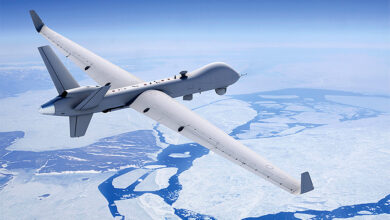The US Department of Defense (DoD) has selected Shield AI’s semi-autonomous, vertical take-off and landing (VTOL) V-BAT drone for its research and engineering pilot program.
The program aims to “transition technologies from pilot programs, prototype projects, and research projects into production,” the DoD wrote.
The V-BAT operates with near-zero emissions and “can provide resilient data transport and locate and provide weapon quality targeting information,” according to the DoD.
It is powered by a single thrust-vectored fan that allows it to travel similar to SpaceX rockets, Shield AI explained.
The drone’s logistical design would allow forces to cut the cost of information and cargo transport as they could deliver supplies to a moving land vehicle or even a Blackhawk helicopter.
U.S. contractors prepare to launch V-BAT 118 for first flight onboard guided-missile destroyer USS Michael Monsoor (DDG 1001) as part of #RIMPAC2022.@US3rdFleet @RimofthePacific @USNavy #FreeAndOpenIndoPacific 📸 MC3 Megan Alexander pic.twitter.com/GYp3OKSUv8
— U.S. Pacific Fleet (@USPacificFleet) July 14, 2022
Hivemind AI
The V-BAT is controlled through artificial intelligence software called Hivemind. The system can be programmed to maneuver autonomously, preventing human-related accidents during operations such as penetrating enemy air defenses, room clearance, and F-16 interceptions.
Hivemind is designed with an algorithm specializing in mapping, planning, and estimation that makes the V-BAT’s flight dynamic, the firm wrote. Like other advanced AI systems, Hivemind can discover, learn, and execute the best possible strategy it has processed.
The software is intended to remain functional when compromised through cloud disconnection or exposed to high-threat environments, as well as GPS and communication-degraded regions.












